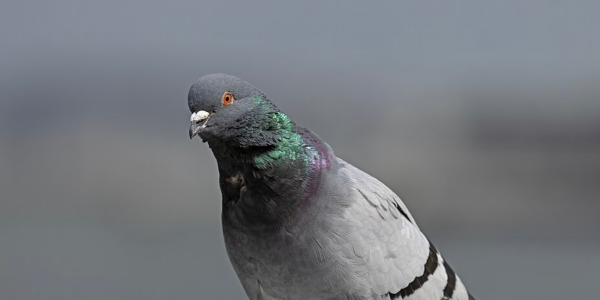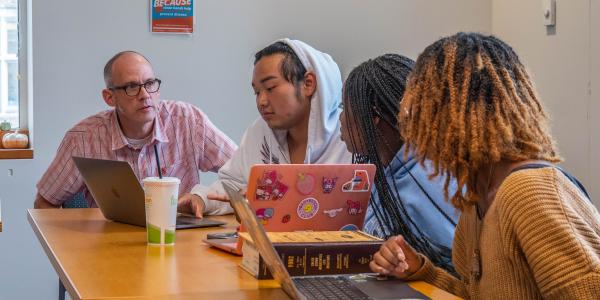With Living Earth Collaborative support, an undergraduate researcher tracked pigeons in two cities, revealing how they thrive in urban life.
Pigeons seem right at home in St. Louis. You can see flocks perching on rooftops and power lines, waiting for a chance to grab a stray scrap of food or dirty a windshield.

Cities have pushed many animals from their habitats, but pigeons thrive in human spaces, said Daisy Lewis, AB ’23, a former WashU undergrad in ecology and evolutionary biology. “Pigeons like to be where people are,” said Lewis, who will be starting a PhD program in integrative biology at the University of California, Berkeley this fall.
To better understand the city ways of these birds, Lewis took long, methodical walks through St. Louis and Madrid, Spain, counting every pigeon she saw and noting the details of the location. She reported her findings in the journal Urban Naturalist. The study’s co-authors are Elizabeth Carlen, a postdoctoral researcher with the Living Earth Collaborative, and Jonathan Losos, the William H. Danforth Distinguished University Professor. The study was supported by the National Science Foundation and the Living Earth Collaborative.
During her junior year, Lewis reached out to Carlen looking for research opportunities. Carlen has a long-standing interest in urban wildlife. When Lewis mentioned that she would be spending a semester abroad in Madrid, an idea quickly formed: Lewis could compare the wildlife in the two cities. “We thought about squirrels, which is one of Liz’s specialties, but we soon decided on pigeons because they’re common in both cities,” Lewis said. “Madrid and St. Louis are very different environments, which speaks to the flexibility and adaptability of the species.”

The project exemplifies the collaborative nature of the Living Earth Collaborative and the opportunities for undergraduate students to participate in LEC-supported research. “Mentorship is a key part of the LEC mission, and it’s always great to work with dedicated undergraduate researchers like Daisy,” Carlen said.
On her long walks, Lewis found that pigeons were nearly four times more common in Madrid than in St. Louis. The pigeons of Madrid were especially abundant anywhere people were eating outside. “If St. Louis had more of an outdoor café culture, it would probably have more pigeons,” Lewis said.
In both cities, pigeons were most commonly seen in places with significant numbers of pedestrians. “It’s no secret that St. Louis isn’t the most walkable city, so it was interesting to see that pigeons seem to prefer places where people are actually walking,” Lewis said. It’s possible, she said, that pigeons congregate near people in part to avoid red-tailed hawks and other potential predators that may be more shy around crowds.
In St. Louis, pigeons also like to hang around train tracks, likely drawn by grain that spills from passing trains. They’re also common under overpasses and throughout downtown, taking advantage of abundant window ledges, rooftops, and power lines for perching. They’re rarely seen in Forest Park, largely leaving it to the warblers, thrushes, and hawks.
Carlen, who studied pigeons as a postdoctoral researcher and was dubbed “The Pigeon Stalker” in a New York Times profile, explained that the pigeons flocking around St. Louis and other cities in the United States aren’t native to the continent. “Pigeons were brought here from Europe by early colonizers for food and as a source of fertilizer,” she said. “Their droppings were valued.”
“Mentorship is a key part of the Living Earth Collaborative’s mission, and it’s always great to work with dedicated undergraduate researchers like Daisy.”
—Elizabeth Carlen
Some of those birds escaped, and their descendants found new lives in cities. “They’re technically feral, which means they are wild descendants of domesticated ancestors,” Lewis said. Wild pigeons occur naturally in Spain, but the flocks that squabble for food scraps outside of cafés in Madrid are the descendants of once-domesticated birds who went feral. “They may have lost some of their wild traits during domestication, perhaps including a natural fear of humans,” she added.

That history helps explain why pigeons thrive in human spaces while still fending for themselves. Pigeon aficionados worldwide often throw seeds and bread at the birds in parks and city squares, but Carlen discourages the practice. “It’s never a good idea to feed wild animals, and that includes animals that were once domesticated,” Carlen said. “Pigeons do just fine on their own.”
Pigeons don’t always have the most stellar reputations, especially among people who clean city sidewalks or statues, but their grit and gregariousness give them a certain charm, Lewis said. “My friends text me when they see a bunch of pigeons, because they’ve become as fond of the birds as I am,” she said. “Pigeons can be quite charismatic, and they’re a great example of opportunistic resilience.”





